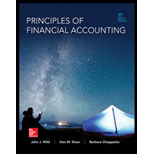
Concept explainers
(1)
Compute the direct materials price variance and quantity variance and indicate whether it is favorable or unfavorable.
(1)
Explanation of Solution
Direct material price variance:
The variation in between actual price and estimated price paid for materials is called material price variance. It is used to determine difference in price paid for material the price that was supposed to be paid for material.
The following formula is used to calculate direct material price variance:
Compute the direct materials price variance and indicate whether it is favorable or unfavorable:
Step 1: Calculate the actual cost of direct materials used.
Step 2: Calculate the
Step 3: Calculate the direct materials price variance.
Direct material quantity variance:
The variance which is used to compare the actual quantity of materials utilized in production with estimated quantity of materials that is supposed to be used in production and helps to find variation is called material quantity variance.
.
The following formula is used to calculate direct material quantity variance:
Compute the direct materials quantity variance and indicate whether it is favorable or unfavorable:
Step 1: Calculate the actual quantity of materials used.
Step 2: Calculate the standard quantity of materials used.
Working note:
Calculate the standard quantity:
Step 3: Calculate the direct materials quantity variance.
Hence, the direct materials price variance is $4,600 (favorable) and direct materials quantity variance is $6,000 (unfavorable).
(2)
Calculate the direct labor rate variances and efficiency variances and indicate whether it is favorable or unfavorable.
(2)
Explanation of Solution
Total Direct Labor Variance
The total direct labor variance is a measure to determine the variation in the standard direct labor and the actual direct labor. This means that the difference between the cost which will be by the standard and the cost which is actually calculated.
Direct Labor Rate Variance
The direct labor rate variance is a measure to determine the variation in the estimated cost of the direct labor and the actual cost of the direct labor.
Compute the direct labor rate variances indicate whether it is favorable or unfavorable:
Direct labor efficiency variance is a measure that determines the difference between the estimated labor quantity and the actual labor quantity used.
Compute the direct labor efficiency variance:
Working note:
Calculate the standard direct labor hours used:
Hence, the direct labor rate variance is $1,880 (unfavorable) and the direct labor efficiency variance is $9,600 (unfavorable).
Want to see more full solutions like this?
Chapter 23 Solutions
Principles of Financial Accounting.

 AccountingAccountingISBN:9781337272094Author:WARREN, Carl S., Reeve, James M., Duchac, Jonathan E.Publisher:Cengage Learning,
AccountingAccountingISBN:9781337272094Author:WARREN, Carl S., Reeve, James M., Duchac, Jonathan E.Publisher:Cengage Learning, Accounting Information SystemsAccountingISBN:9781337619202Author:Hall, James A.Publisher:Cengage Learning,
Accounting Information SystemsAccountingISBN:9781337619202Author:Hall, James A.Publisher:Cengage Learning, Horngren's Cost Accounting: A Managerial Emphasis...AccountingISBN:9780134475585Author:Srikant M. Datar, Madhav V. RajanPublisher:PEARSON
Horngren's Cost Accounting: A Managerial Emphasis...AccountingISBN:9780134475585Author:Srikant M. Datar, Madhav V. RajanPublisher:PEARSON Intermediate AccountingAccountingISBN:9781259722660Author:J. David Spiceland, Mark W. Nelson, Wayne M ThomasPublisher:McGraw-Hill Education
Intermediate AccountingAccountingISBN:9781259722660Author:J. David Spiceland, Mark W. Nelson, Wayne M ThomasPublisher:McGraw-Hill Education Financial and Managerial AccountingAccountingISBN:9781259726705Author:John J Wild, Ken W. Shaw, Barbara Chiappetta Fundamental Accounting PrinciplesPublisher:McGraw-Hill Education
Financial and Managerial AccountingAccountingISBN:9781259726705Author:John J Wild, Ken W. Shaw, Barbara Chiappetta Fundamental Accounting PrinciplesPublisher:McGraw-Hill Education





